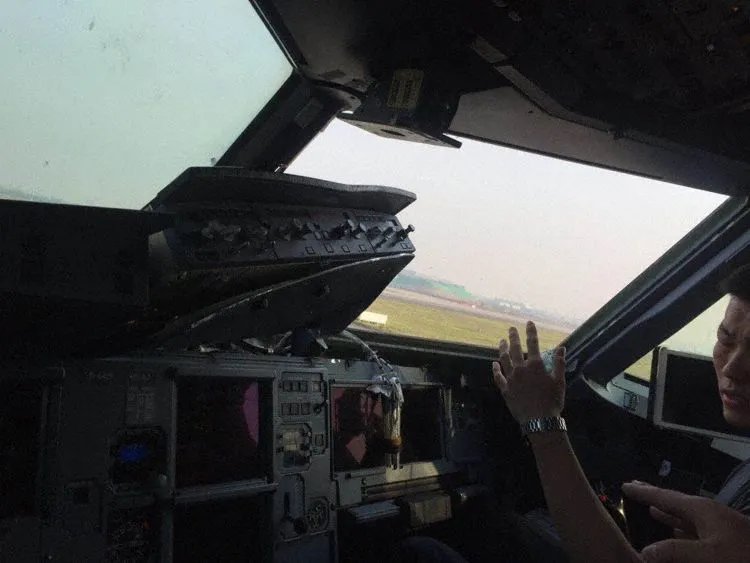
Cockpit window emergency hurts pilot
May 16, 2018

In a recent incident, a pilot was seriously injured when the cockpit window unexpectedly shattered during flight. The sudden breakage caused a rapid loss of cabin pressure, leading to a chaotic environment inside the cockpit. The pilot struggled to maintain control of the aircraft while dealing with the intense winds and debris. Emergency protocols were activated, and the co-pilot quickly took charge, ensuring the safety of passengers as they prepared for an emergency descent. The incident highlights the critical importance of cockpit safety measures and the need for thorough inspections to prevent such hazardous situations in the future.
In aviation, safety is paramount, particularly in the cockpit where pilots are responsible for the aircraft and the lives of their passengers. However, situations can arise that put pilots in harm's way, such as incidents involving cockpit windows. Understanding these emergencies, their causes, and how they can be mitigated are crucial for the safety of flight operations. This article explores the implications of cockpit window emergencies and their potential impact on pilots.
Understanding Cockpit Window Emergencies
Cockpit windows are designed to withstand extreme conditions, including high altitudes and rapid changes in pressure. However, they can still fail due to a variety of reasons, including manufacturing defects, wear and tear, or unexpected external factors. When a cockpit window breaks or fails, it can lead to rapid decompression, which poses a significant threat to the pilot's safety.
Causes of Cockpit Window Failures
Several factors can contribute to cockpit window failures. Here's a breakdown of common causes:
| Cause | Description |
|---|---|
| Manufacturing Defects | Flaws in the materials or construction process can lead to weaknesses in the window. |
| Wear and Tear | Over time, environmental factors like UV exposure and temperature fluctuations can weaken the window's integrity. |
| External Impact | Bird strikes or debris can cause sudden damage to the cockpit window. |
| Improper Maintenance | Failure to regularly inspect and maintain cockpit windows can lead to undetected issues. |
Impacts on Pilots During Emergencies
When a cockpit window emergency occurs, the immediate effects can be alarming. Rapid decompression can lead to a drop in oxygen levels, causing disorientation and physical harm to the pilot. The following are some potential impacts:
- Oxygen Deprivation: As cabin pressure drops, pilots may experience hypoxia, which impairs cognitive functions and reaction times.
- Temperature Exposure: A broken window can expose pilots to extreme temperatures, which can lead to frostbite or other cold-related injuries.
- Physical Injuries: Shattered glass can pose a risk of cuts or lacerations during an emergency situation.
Emergency Protocols for Pilots
In the event of a cockpit window failure, pilots are trained to follow specific emergency protocols to ensure their safety and that of their passengers. These protocols include:
- Immediate Action: Pilots must quickly assess the situation and determine the need for an emergency descent to a lower altitude where oxygen levels are normal.
- Communication: Pilots should inform air traffic control of the emergency situation and their intentions, ensuring that other aircraft are aware of the situation.
- Use of Oxygen Masks: If necessary, pilots will don oxygen masks to maintain adequate oxygen levels during the emergency.
Preventive Measures for Cockpit Window Integrity
To minimize the risk of cockpit window emergencies, airlines and manufacturers implement various preventive measures:
- Regular Inspections: Scheduled maintenance checks are vital to identify any wear or damage to cockpit windows before they lead to emergencies.
- Quality Materials: Using high-quality materials for cockpit windows can enhance their durability and resistance to failures.
- Training and Simulation: Pilots undergo rigorous training and simulations to prepare for emergency scenarios, ensuring they can react effectively when it matters most.
The Role of Technology in Enhancing Safety
Advancements in technology have significantly improved cockpit safety. Modern aircraft are equipped with sensors and monitoring systems that can detect changes in pressure or integrity of cockpit windows. These systems can alert pilots to potential issues before they escalate into emergencies.
Conclusion
While cockpit window emergencies can pose serious risks to pilots, understanding the causes and implementing preventive measures can mitigate these dangers. Comprehensive training, regular maintenance, and the use of advanced technology are essential components in ensuring the safety of pilots and passengers alike. As the aviation industry continues to evolve, ongoing research and development will play a crucial role in enhancing cockpit safety and preventing emergencies related to cockpit windows.
Related Articles

Explore Thailand: The Best Islands to Visit for Paradise, Adventure, and Relaxation

The Ultimate Guide to the Best Islands in Thailand for Your Next Getaway

Do babies need passports? How to get a passport for a newborn

How to get a U.S. passport fast: here’s how to expedite the process

What is Mobile Passport Control: 5 reasons why you should use it

SENTRI vs. Global Entry: A detailed guide

Do you need a passport to go to the Bahamas? Let’s find out

Do you need a passport to go to Mexico? A detailed guide

Do you need a passport to go to Canada? We got the answer

Do You Need a Passport for a Cruise: An Essential Travel Guide

Booster Seat Requirements: All the Rules to Follow in Your Rental Car

What Are the World’s Most Powerful Passports, and How Does Yours Rank?

How to Take a Passport Photo at Home: A Helpful Guide

You've got to have heart! Southwest's new livery

Your opinion: Should water be free on low cost carriers?

Young women bolder than guys as solo travellers
